Kickstart your culinary adventure with our roundup of 20 Delicious Chinese Sauces Recipes Amazing! Whether you’re whipping up a quick weeknight dinner or diving into the comfort of homemade flavors, these sauces are your ticket to transforming simple ingredients into extraordinary meals. Perfect for home cooks eager to explore the rich tapestry of Chinese cuisine, each recipe promises to delight your taste buds. Ready to get saucy? Let’s dive in!
Sweet and Sour Sauce
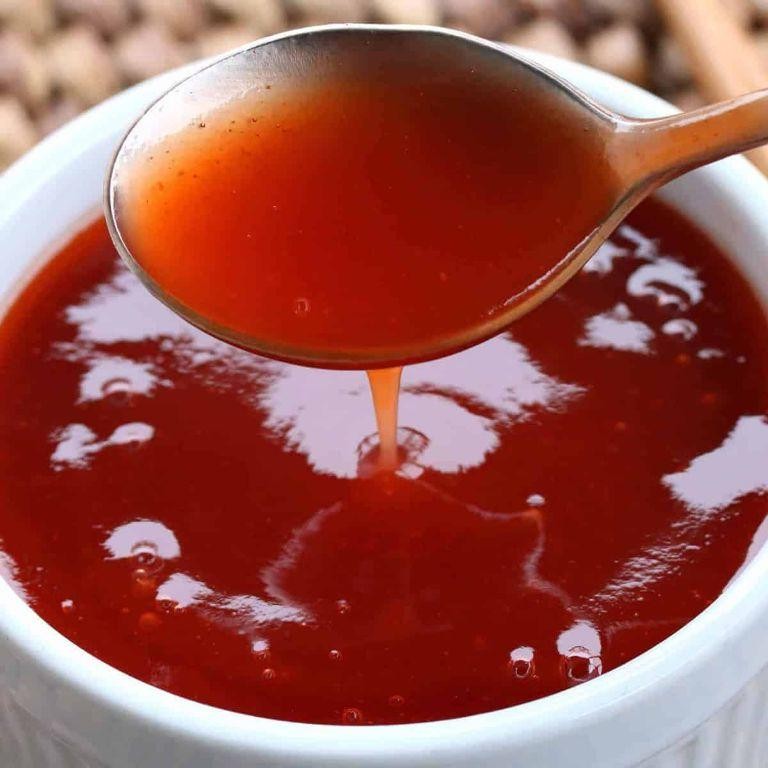
Here’s how to whip up a homemade Sweet and Sour Sauce that’s perfectly balanced between tangy and sweet, ideal for drizzling over your favorite dishes or as a dipping companion.
Ingredients
- 1 cup pineapple juice (the secret to its fruity sweetness)
- 1/3 cup rice vinegar (for that essential tang)
- 1/2 cup brown sugar (packed, for depth of flavor)
- 2 tbsp ketchup (adds a rich color and slight umami)
- 1 tbsp soy sauce (I always go for low-sodium to control the saltiness)
- 1/4 tsp garlic powder (a quick hack when fresh isn’t handy)
- 1/4 tsp ginger powder (same as above, but fresh grated ginger works wonders too)
- 2 tbsp cornstarch (mixed with 2 tbsp water, this is your thickening agent)
Instructions
- In a medium saucepan over medium heat, combine pineapple juice, rice vinegar, brown sugar, ketchup, soy sauce, garlic powder, and ginger powder. Stir until the sugar dissolves completely.
- Bring the mixture to a gentle boil, then reduce heat to low. Simmer for 5 minutes, stirring occasionally to prevent sticking.
- In a small bowl, whisk together cornstarch and water until smooth. Gradually stir this slurry into the saucepan.
- Increase heat to medium and cook, stirring constantly, until the sauce thickens to your desired consistency, about 2-3 minutes. Tip: The sauce will continue to thicken as it cools, so aim for slightly thinner than you’d like.
- Remove from heat and let cool for 5 minutes before serving. Tip: For a smoother sauce, strain through a fine mesh sieve to remove any lumps.
Perfectly glossy and vibrant, this Sweet and Sour Sauce clings beautifully to proteins and veggies alike. Try it as a glaze for grilled chicken or a bold dip for spring rolls to elevate your meal instantly.
Hoisin Sauce
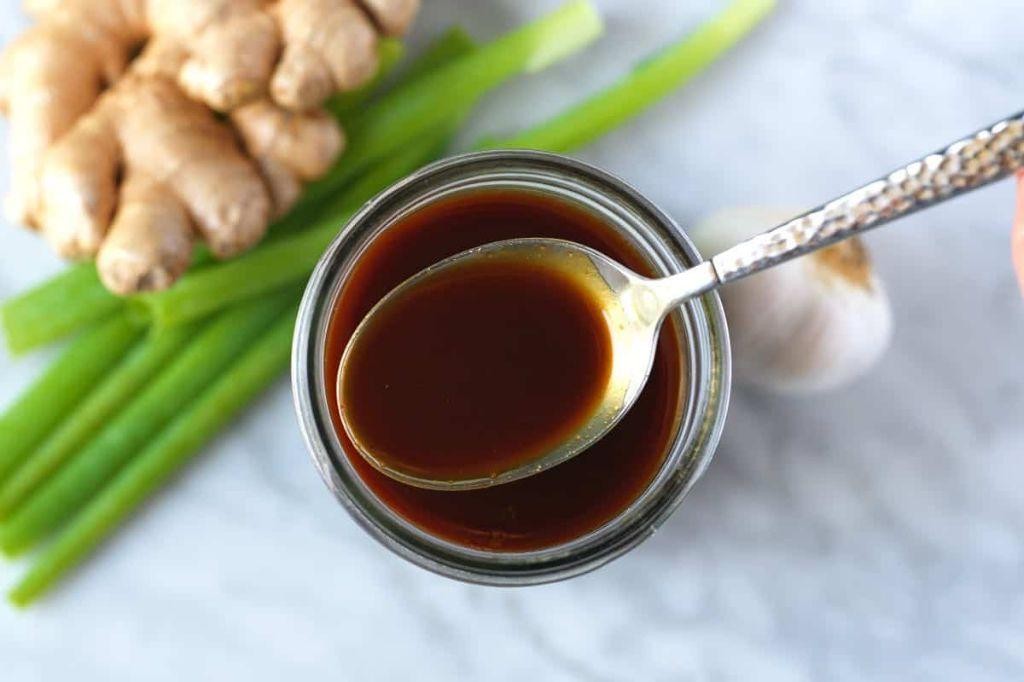
Now, let’s dive into the world of homemade Hoisin Sauce, a versatile and flavorful condiment that’s easier to make than you might think. Perfect for glazes, marinades, or dipping, this sauce will elevate your dishes with its sweet and savory profile.
Ingredients
- 1/2 cup soy sauce (I always opt for low-sodium to control the saltiness)
- 1/4 cup peanut butter (creamy works best for a smooth texture)
- 2 tbsp honey (for that natural sweetness)
- 1 tbsp white vinegar (a splash adds the perfect tang)
- 2 tsp sesame oil (toasted sesame oil is my favorite for its nutty flavor)
- 1 garlic clove, minced (freshly minced garlic makes all the difference)
- 1/2 tsp Chinese five-spice powder (this is the secret to its unique flavor)
- 1/4 tsp black pepper (freshly ground for the best aroma)
Instructions
- In a medium bowl, combine the soy sauce and peanut butter, whisking until the peanut butter is fully dissolved into the soy sauce.
- Add the honey and white vinegar to the mixture, continuing to whisk until the honey is completely incorporated.
- Stir in the sesame oil, minced garlic, Chinese five-spice powder, and black pepper, ensuring all ingredients are well blended.
- Let the sauce sit for at least 30 minutes before using to allow the flavors to meld together beautifully.
- For a smoother consistency, you can blend the sauce in a food processor for about 30 seconds. Tip: If the sauce is too thick, a tablespoon of warm water can thin it to your desired consistency.
- Store the hoisin sauce in an airtight container in the refrigerator for up to two weeks. Tip: Always give it a good stir before using, as the ingredients may separate over time.
- Use this sauce as a glaze for grilled meats, a stir-fry enhancer, or a dipping sauce for spring rolls. Tip: For an extra kick, a dash of sriracha can be added to the mix.
This homemade hoisin sauce boasts a rich, velvety texture with a perfect balance of sweet, salty, and umami flavors. Try drizzling it over roasted vegetables or mixing it into your next batch of fried rice for an instant flavor upgrade.
Oyster Sauce
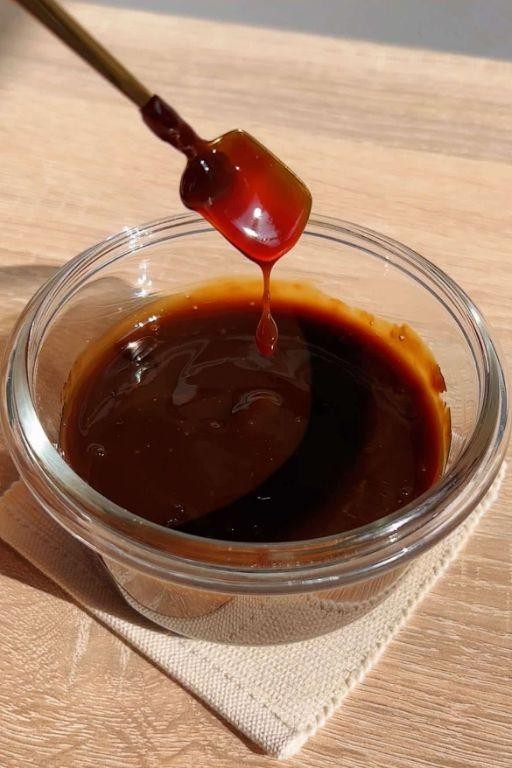
Discovering the rich, umami-packed world of oyster sauce can transform your cooking from good to unforgettable. This versatile condiment, a staple in Asian cuisine, is surprisingly easy to incorporate into your dishes, offering depth and complexity with just a spoonful.
Ingredients
- 1/2 cup oyster sauce (I always reach for the premium brand with the blue label for its superior depth of flavor.)
- 2 tbsp water (to adjust consistency, though I find room temperature works best.)
- 1 tbsp sugar (A little sweetness balances the saltiness beautifully.)
- 1 tsp cornstarch (This is my secret for a glossy, thick sauce that clings to every bite.)
Instructions
- In a small bowl, whisk together the oyster sauce and water until fully combined. Tip: Always start with less water; you can add more if needed.
- Add the sugar to the mixture, stirring until it’s completely dissolved. This step ensures a smooth, unified flavor.
- Sprinkle in the cornstarch, whisking continuously to prevent any lumps from forming. Tip: Sifting the cornstarch beforehand can help achieve a silkier texture.
- Transfer the mixture to a small saucepan and heat over medium-low heat, stirring constantly, until the sauce thickens to your desired consistency, about 3-5 minutes. Tip: Keep the heat low to avoid scorching the sauce.
Now you’ve got a lusciously thick, savory-sweet oyster sauce that’s perfect for drizzling over steamed vegetables, stir-fries, or even as a marinade. Next time, try tossing it with noodles for an instant flavor upgrade.
Szechuan Sauce
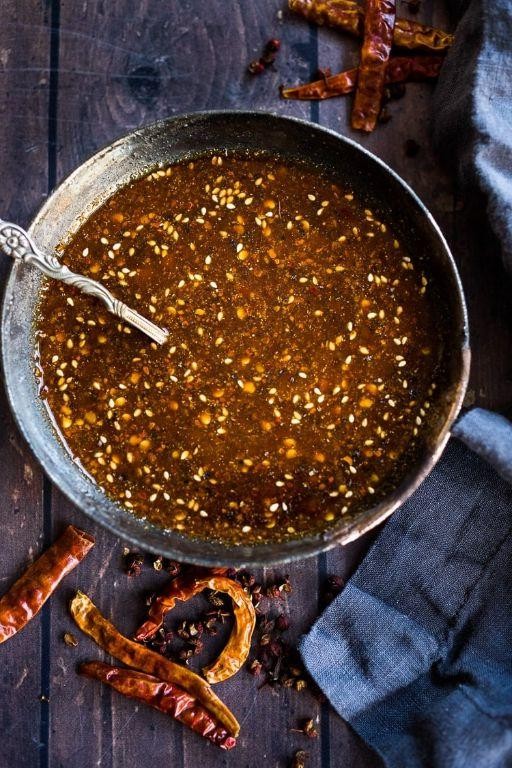
Discover the bold and fiery flavors of Szechuan Sauce, a staple in Chinese cuisine that’s surprisingly simple to make at home. This guide will walk you through each step, ensuring you achieve that perfect balance of heat and tang.
Ingredients
- 1/4 cup soy sauce (I always opt for low-sodium to control the saltiness)
- 2 tbsp rice vinegar (adds a subtle sweetness)
- 1 tbsp sesame oil (toasted for that nutty aroma)
- 1 tbsp honey (for a touch of sweetness)
- 2 tsp Szechuan peppercorns (toasted and ground, they’re the heart of the sauce)
- 1 tsp crushed red pepper flakes (adjust based on your heat preference)
- 2 cloves garlic, minced (fresh is best for that pungent kick)
- 1 tsp ginger, grated (adds a warm, spicy note)
Instructions
- In a small bowl, whisk together the soy sauce, rice vinegar, sesame oil, and honey until well combined.
- Toast the Szechuan peppercorns in a dry skillet over medium heat for about 2 minutes, or until fragrant. Let them cool, then grind into a fine powder.
- Add the ground peppercorns, red pepper flakes, minced garlic, and grated ginger to the soy sauce mixture. Stir until everything is evenly incorporated.
- Let the sauce sit for at least 30 minutes before serving to allow the flavors to meld together. Tip: The longer it sits, the more intense the flavors become.
- Give the sauce a good stir before using. Tip: If you prefer a smoother texture, you can strain the sauce to remove the garlic and ginger bits.
- Store any leftover sauce in an airtight container in the refrigerator for up to a week. Tip: This sauce also freezes well for longer storage.
Feel the complex layers of heat, sweetness, and umami in every bite of this Szechuan Sauce. It’s perfect for drizzling over noodles, as a marinade for meats, or even as a bold dipping sauce for dumplings.
Black Bean Sauce
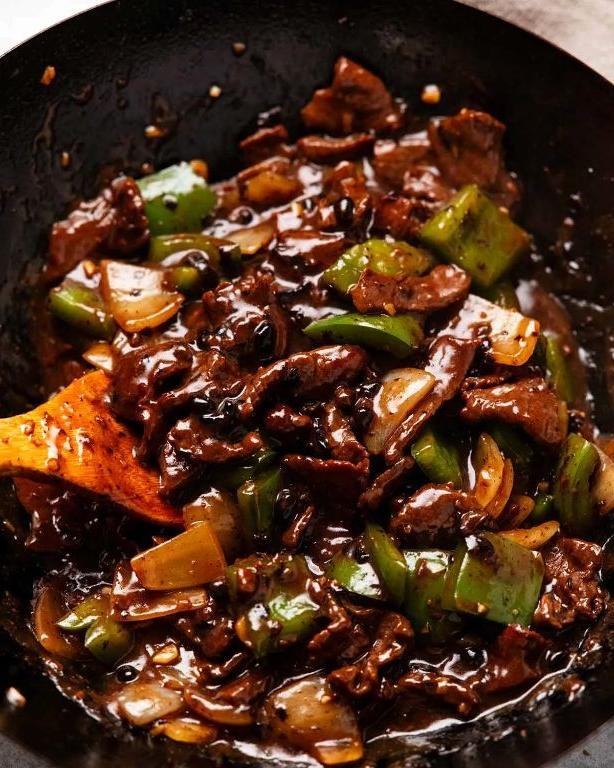
One of the most versatile and flavorful additions to your cooking repertoire is a homemade Black Bean Sauce. This guide will walk you through the process, ensuring even beginners can achieve a rich, savory sauce perfect for a variety of dishes.
Ingredients
- 1 cup dried black beans (soaked overnight, they plump up beautifully)
- 2 tbsp extra virgin olive oil (my go-to for its fruity notes)
- 3 cloves garlic (minced, because fresh is always best)
- 1 small onion (diced, for a sweet foundation)
- 1 tsp cumin (toasted and ground, it makes all the difference)
- 2 cups vegetable broth (homemade or store-bought, but low sodium preferred)
- 1 tbsp soy sauce (for that umami depth)
- 1 tsp smoked paprika (it adds a subtle smokiness)
Instructions
- Drain the soaked black beans and rinse them under cold water until the water runs clear.
- Heat the olive oil in a large saucepan over medium heat (about 300°F) until shimmering.
- Add the diced onion and minced garlic to the pan, sautéing until translucent (about 5 minutes). Tip: Stir frequently to prevent burning.
- Stir in the cumin and smoked paprika, cooking for another minute until fragrant. Tip: Toasting spices releases their essential oils, enhancing flavor.
- Add the black beans and vegetable broth to the saucepan, bringing the mixture to a boil.
- Reduce the heat to low, cover, and simmer for 1 hour, or until the beans are tender. Tip: Skim off any foam that forms on the surface for a clearer sauce.
- Remove from heat, stir in the soy sauce, and let cool slightly before blending to your desired consistency.
Unbelievably rich and velvety, this Black Bean Sauce clings beautifully to noodles or can be the star in a veggie stir-fry. Its deep, smoky flavors are a testament to the power of simple ingredients transformed with care.
Plum Sauce
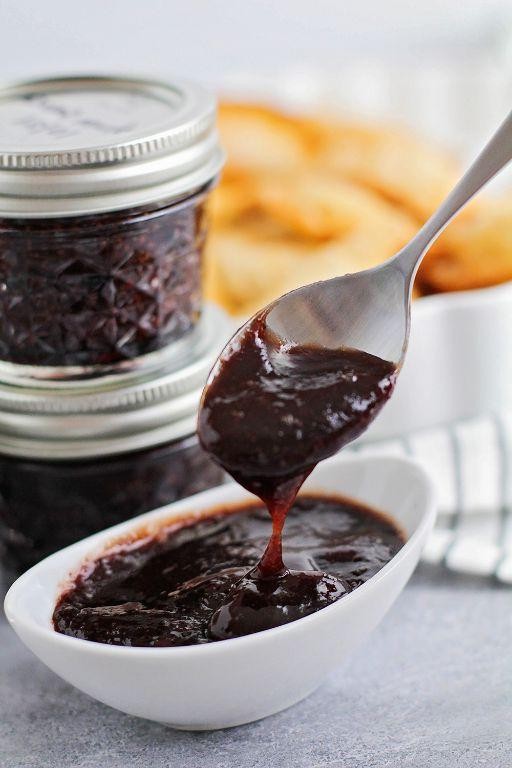
Haven’t you ever found yourself with a surplus of plums and wondered what to do with them? Today, we’re turning those juicy plums into a versatile plum sauce that’s perfect for glazing, dipping, or even as a base for your next barbecue sauce. Let’s get started.
Ingredients
- 2 cups pitted and chopped plums (I like to leave the skin on for extra texture and color)
- 1/2 cup granulated sugar (adjust based on the sweetness of your plums)
- 1/4 cup apple cider vinegar (for that tangy kick)
- 1 tbsp grated ginger (fresh is always best, but powdered works in a pinch)
- 1/2 tsp cinnamon (a little goes a long way)
- 1/4 tsp cloves (for a warm, spicy note)
- 1/4 cup water (to help everything meld together beautifully)
Instructions
- Combine all ingredients in a medium saucepan over medium heat. Stir to mix well.
- Bring the mixture to a boil, then reduce the heat to low. Let it simmer for about 25 minutes, stirring occasionally to prevent sticking. Tip: A wooden spoon is perfect for stirring as it won’t react with the acidic ingredients.
- After 25 minutes, the plums should be completely broken down, and the sauce thickened. If you prefer a smoother sauce, use an immersion blender to puree it right in the pot. Tip: For a chunkier sauce, mash the plums with a potato masher instead.
- Let the sauce cool for about 10 minutes before transferring it to a jar or container. Tip: Sterilizing your jar beforehand can help extend the shelf life of your sauce.
Creating this plum sauce is just the beginning. Its rich, tangy, and slightly spicy flavor profile makes it an excellent companion for grilled meats, a unique addition to cheese boards, or even as a sweet and sour glaze for roasted vegetables. The possibilities are as endless as they are delicious.
Chili Garlic Sauce
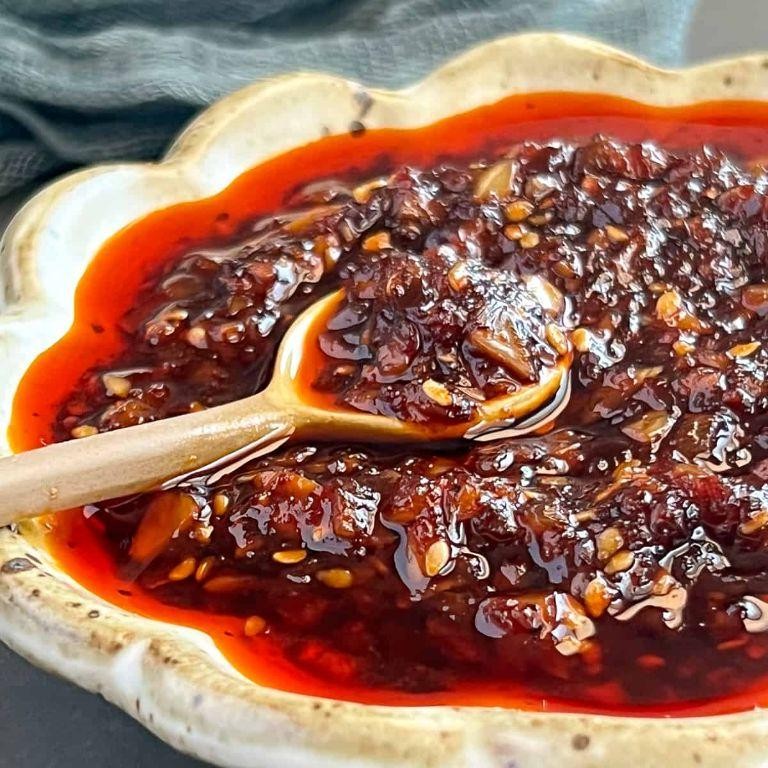
Discover the vibrant world of homemade Chili Garlic Sauce, a condiment that packs a punch and elevates any dish with its fiery and garlicky flavors. Perfect for beginners, this recipe guides you through each step to create a sauce that’s both versatile and delicious.
Ingredients
- 1 cup red chili peppers, finely chopped (I love using a mix of Thai and serrano for heat and flavor)
- 1/2 cup garlic cloves, minced (fresh is best for that sharp, aromatic kick)
- 1/4 cup apple cider vinegar (it adds a nice tanginess that balances the heat)
- 2 tbsp sugar (to round out the flavors, I find white sugar works best here)
- 1 tsp salt (sea salt is my preference for its clean taste)
- 1/2 cup water (filtered water ensures no off flavors)
Instructions
- In a medium saucepan, combine the chopped chili peppers, minced garlic, apple cider vinegar, sugar, salt, and water.
- Bring the mixture to a boil over medium-high heat, then reduce to a simmer. Tip: Stir occasionally to prevent sticking and ensure even cooking.
- Simmer for 20 minutes, or until the chilies and garlic are soft and the liquid has reduced slightly. Tip: The sauce should coat the back of a spoon when it’s ready.
- Remove from heat and let cool for 10 minutes. Tip: Cooling slightly before blending makes the sauce smoother.
- Transfer the mixture to a blender and blend until smooth. For a chunkier sauce, pulse a few times instead.
- Pour the sauce into a clean jar and let it cool completely before sealing. Store in the refrigerator for up to a month.
Freshly made Chili Garlic Sauce boasts a glossy texture and a balance of heat, sweetness, and tang. Try it as a marinade for grilled meats or stir it into noodles for an instant flavor boost.
Soy Sauce Based Marinade
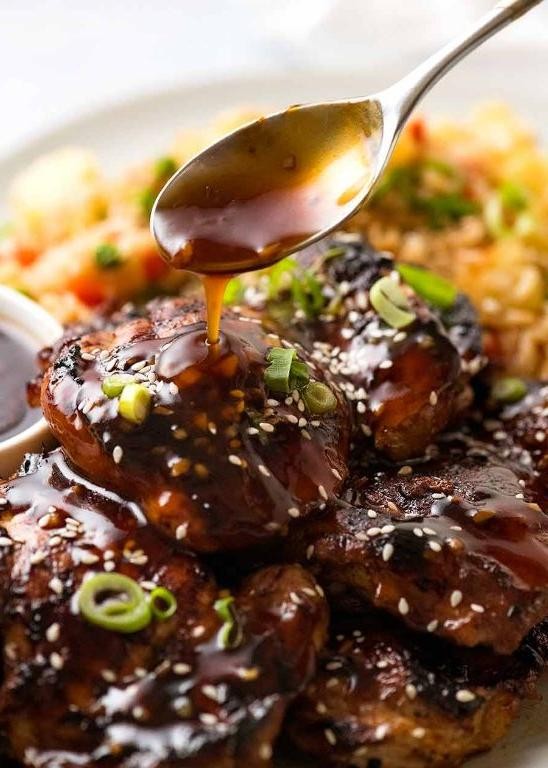
Before you dive into the world of marinades, let’s start with a soy sauce-based one that’s both versatile and packed with umami. This marinade is perfect for beginners, offering a balance of flavors that can elevate any protein.
Ingredients
- 1/2 cup soy sauce (I always opt for low-sodium to control the saltiness better.)
- 1/4 cup honey (Local honey adds a lovely floral note.)
- 2 tbsp rice vinegar (This brings a subtle tang that brightens the marinade.)
- 2 cloves garlic, minced (Freshly minced garlic makes all the difference.)
- 1 tbsp ginger, grated (A microplane grater works wonders here.)
- 1/2 tsp sesame oil (Just a dash adds depth.)
- 1/4 tsp red pepper flakes (Adjust according to your heat preference.)
Instructions
- In a medium bowl, whisk together the soy sauce, honey, and rice vinegar until the honey is fully dissolved.
- Add the minced garlic, grated ginger, sesame oil, and red pepper flakes to the bowl. Stir to combine all ingredients thoroughly.
- Place your protein of choice in a resealable bag or shallow dish. Pour the marinade over, ensuring it’s fully coated. Tip: For even flavor, massage the marinade into the protein.
- Seal the bag or cover the dish. Refrigerate for at least 2 hours, though overnight marinating yields deeper flavors. Tip: Turn the protein occasionally for uniform marination.
- When ready to cook, remove the protein from the marinade, letting excess drip off. Tip: For grilling, pat the protein dry to prevent flare-ups.
- Cook the protein as desired, discarding the used marinade. The marinade is not suitable for reuse due to raw protein contact.
Unlock the full potential of this marinade by serving your cooked protein over a bed of steamed jasmine rice, garnished with sliced green onions and sesame seeds. The marinade imparts a glossy, caramelized exterior with a savory-sweet flavor profile that’s irresistibly delicious.
Teriyaki Sauce
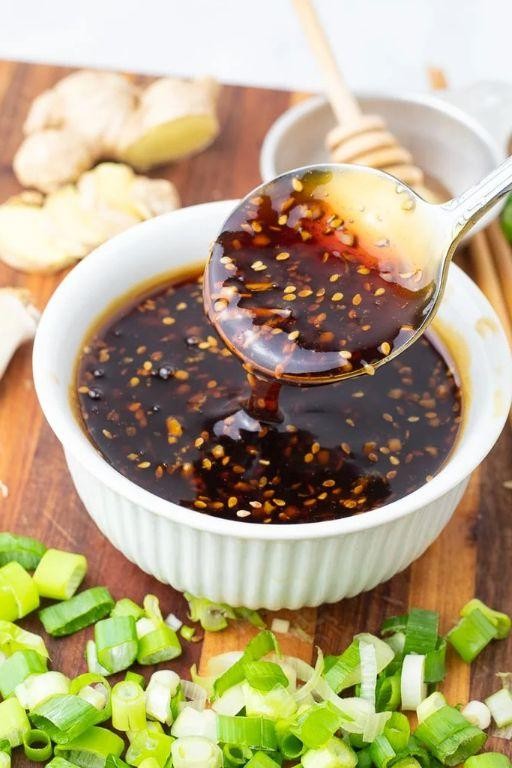
Teriyaki sauce is a versatile and flavorful addition to any dish, offering a perfect balance of sweet and savory. Today, we’ll walk through how to make this classic sauce from scratch, ensuring you can enjoy its rich flavor anytime.
Ingredients
- 1/2 cup soy sauce (I always opt for low-sodium to control the saltiness)
- 1/4 cup brown sugar (packed tightly for that deep sweetness)
- 2 tablespoons honey (for a natural sweetness that complements the brown sugar)
- 1 tablespoon rice vinegar (it adds a subtle tang that brightens the sauce)
- 1 teaspoon grated ginger (freshly grated makes all the difference)
- 2 cloves garlic, minced (because garlic is the soul of flavor)
- 1 tablespoon cornstarch (mixed with 2 tablespoons cold water to thicken the sauce perfectly)
Instructions
- In a small saucepan over medium heat, combine the soy sauce, brown sugar, honey, rice vinegar, ginger, and garlic. Stir until the sugar has completely dissolved.
- Bring the mixture to a gentle boil, then reduce the heat to low. Let it simmer for about 5 minutes, allowing the flavors to meld together beautifully.
- In a separate bowl, whisk together the cornstarch and cold water until smooth. This is your slurry, which will thicken the sauce.
- Slowly pour the slurry into the simmering sauce, stirring constantly to prevent any lumps from forming. Continue to cook for another 2 minutes, or until the sauce has thickened to your desired consistency.
- Remove the saucepan from the heat and let the teriyaki sauce cool slightly before using. It will thicken a bit more as it cools.
Once cooled, this teriyaki sauce will have a glossy finish and a rich, umami-packed flavor that’s irresistible. Drizzle it over grilled chicken, stir it into fried rice, or use it as a marinade for an extra flavor boost. The possibilities are endless with this homemade teriyaki sauce.
Char Siu Sauce
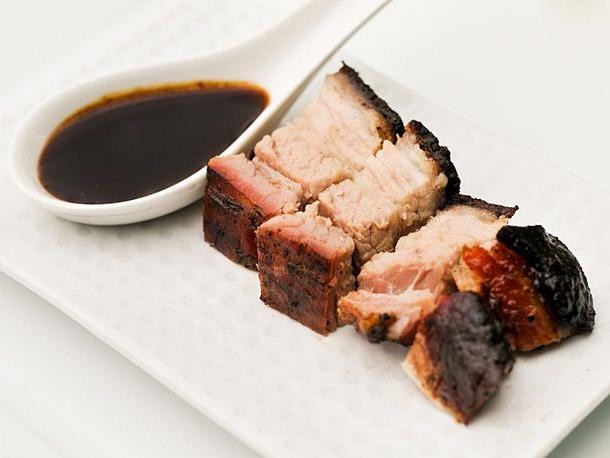
Kickstart your culinary adventure with this homemade Char Siu Sauce, a staple in Chinese cuisine that brings a perfect balance of sweet and savory to your dishes. Let’s dive into creating this versatile sauce that can transform your meals into something extraordinary.
Ingredients
- 1/2 cup hoisin sauce (the backbone of our sauce, providing depth and richness)
- 1/4 cup honey (for that irresistible sweetness; I love using local honey for its floral notes)
- 2 tablespoons soy sauce (opt for low-sodium to control the saltiness)
- 1 tablespoon rice vinegar (adds a subtle tang that brightens the sauce)
- 2 cloves garlic, minced (fresh is best here for that pungent kick)
- 1 teaspoon five-spice powder (the secret ingredient that ties everything together)
- 1/2 teaspoon red food coloring (optional, but it gives that classic vibrant hue)
Instructions
- In a medium saucepan, combine the hoisin sauce, honey, soy sauce, rice vinegar, minced garlic, and five-spice powder over low heat.
- Stir the mixture continuously for about 5 minutes, ensuring all ingredients are well incorporated and the sauce begins to thicken slightly.
- If using, add the red food coloring now, stirring until the color is evenly distributed throughout the sauce.
- Remove the saucepan from the heat and let the sauce cool to room temperature before using. This allows the flavors to meld together beautifully.
Best enjoyed, this Char Siu Sauce boasts a glossy finish with a complex flavor profile that’s both sweet and savory. Try it as a marinade for pork, a glaze for roasted vegetables, or even as a dipping sauce for spring rolls to elevate your meal.
Chinese Mustard Sauce
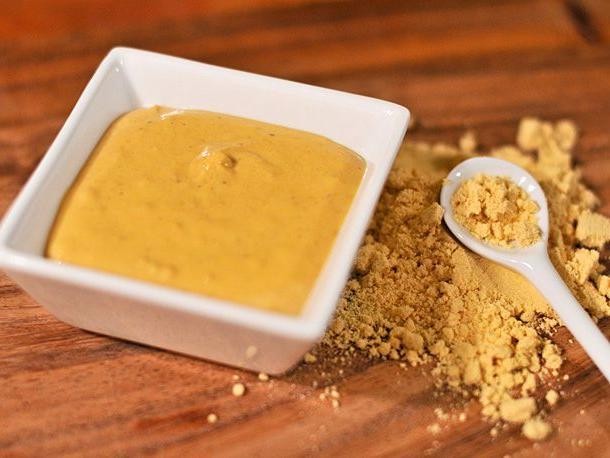
Kitchens across the US are embracing the bold flavors of Chinese cuisine, and today, we’re diving into how to make your own Chinese Mustard Sauce. This condiment is a game-changer for dressings, dips, and marinades, offering a punchy, spicy kick that’s surprisingly easy to whip up at home.
Ingredients
- 1/2 cup dry mustard powder (I find the Colman’s brand packs the perfect heat)
- 1/2 cup cold water (for a smoother paste, use filtered water)
- 1/4 cup rice vinegar (this adds a subtle sweetness that balances the heat)
- 1 tsp salt (I prefer sea salt for its clean taste)
- 1 tbsp sugar (a little sweetness rounds out the flavors)
- 1 tbsp vegetable oil (this helps to emulsify the sauce for a silky texture)
Instructions
- In a medium bowl, whisk together the mustard powder and cold water until a smooth paste forms. Let it sit for 10 minutes to allow the flavors to meld.
- Add the rice vinegar, salt, and sugar to the mustard paste, whisking until fully incorporated. The vinegar will react with the mustard, intensifying its heat.
- Slowly drizzle in the vegetable oil while continuously whisking to emulsify the sauce. This step is crucial for achieving that luxurious, creamy texture.
- Transfer the sauce to a clean jar or bottle and refrigerate for at least 1 hour before serving. Chilling helps to mellow the sharpness and blend the flavors.
Perfect for spicing up sandwiches, burgers, or as a dipping sauce for spring rolls, this Chinese Mustard Sauce boasts a creamy texture with a fiery kick that’s balanced by a hint of sweetness. Try mixing a spoonful into your next salad dressing for an unexpected twist.
Peking Duck Sauce

You might think making Peking Duck Sauce at home is daunting, but with these simple steps, you’ll master it in no time. Let’s dive into the process, ensuring every detail is covered for that authentic flavor.
Ingredients
- 1 cup hoisin sauce (I find the brand ‘Lee Kum Kee’ offers the perfect balance of sweetness and depth)
- 2 tablespoons honey (local, raw honey adds a lovely floral note)
- 1 tablespoon soy sauce (I always opt for low-sodium to control the saltiness)
- 1 teaspoon sesame oil (a dash of toasted sesame oil elevates the aroma)
- 1/2 teaspoon five-spice powder (this is my secret weapon for that signature complexity)
- 2 tablespoons water (to adjust consistency, as needed)
Instructions
- In a small saucepan, combine the hoisin sauce, honey, soy sauce, sesame oil, and five-spice powder over low heat. Stir gently to blend the ingredients without splashing.
- Heat the mixture for about 5 minutes, stirring constantly, until it becomes smooth and slightly thickened. Tip: Keep the heat low to prevent the sugars from burning.
- Gradually add water, one tablespoon at a time, stirring after each addition, until the sauce reaches your desired consistency. Tip: The sauce should coat the back of a spoon but still drip slowly.
- Remove the saucepan from the heat and let the sauce cool to room temperature before serving. Tip: Cooling allows the flavors to meld together beautifully.
This Peking Duck Sauce boasts a glossy texture and a harmonious blend of sweet, savory, and aromatic flavors. Try drizzling it over roasted vegetables or using it as a dipping sauce for spring rolls to explore its versatility.
General Tso’s Sauce
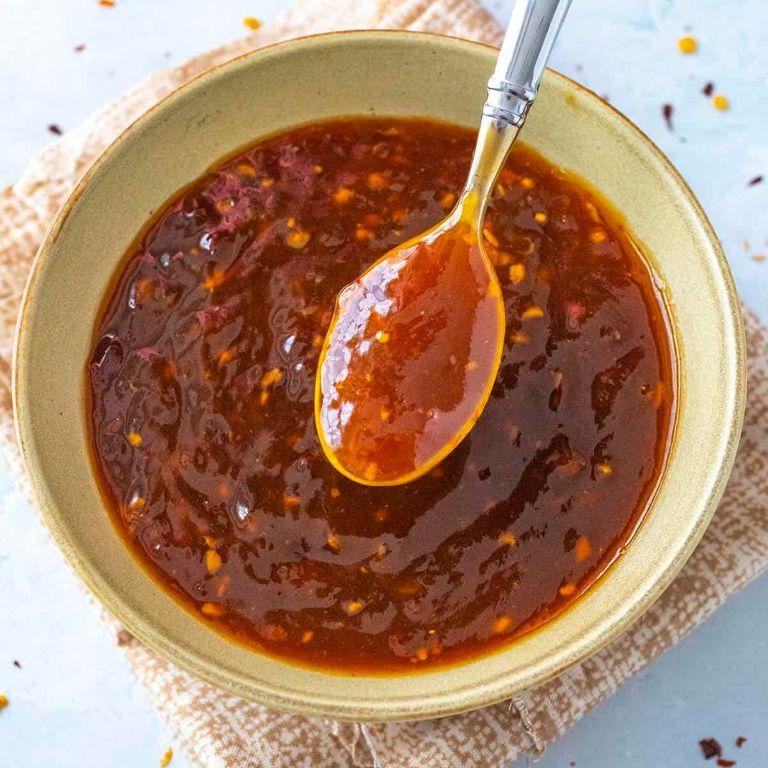
Let’s dive into making a homemade General Tso’s Sauce that’s bursting with flavor and easier than you might think. Perfect for coating your favorite protein or veggies, this sauce is a game-changer for weeknight dinners.
Ingredients
- 1/2 cup ketchup (I find organic ketchup gives a richer flavor)
- 1/4 cup soy sauce (low sodium works great if you’re watching salt intake)
- 1/4 cup rice vinegar (the slight sweetness is key)
- 3 tbsp brown sugar (packed for that deep molasses taste)
- 2 tbsp hoisin sauce (my secret ingredient for complexity)
- 1 tbsp sesame oil (toasted sesame oil adds a nutty depth)
- 2 cloves garlic, minced (fresh is best here for a pungent kick)
- 1 tsp ginger, grated (keep a knob in the freezer for easy grating)
- 1/2 tsp red pepper flakes (adjust based on your heat preference)
- 1 tbsp cornstarch (for that glossy, thick finish)
- 1/4 cup water (to help dissolve the cornstarch)
Instructions
- In a medium bowl, whisk together ketchup, soy sauce, rice vinegar, brown sugar, hoisin sauce, sesame oil, minced garlic, grated ginger, and red pepper flakes until well combined.
- In a small separate bowl, dissolve cornstarch in water to create a slurry, ensuring there are no lumps.
- Pour the sauce mixture into a saucepan over medium heat. Bring to a gentle simmer, stirring occasionally, about 3 minutes.
- Slowly add the cornstarch slurry to the simmering sauce, stirring continuously to prevent clumping.
- Continue to cook the sauce for another 2-3 minutes, or until it thickens to your desired consistency. Tip: The sauce will thicken further as it cools.
- Remove from heat and let it sit for a minute before using. Tip: For a smoother sauce, strain it through a fine mesh sieve.
- Use immediately or store in an airtight container in the fridge for up to a week. Tip: This sauce freezes well, so consider making a double batch.
Mastering this General Tso’s Sauce means you’ll have a versatile, flavorful condiment ready to elevate any dish. Its perfect balance of sweet, tangy, and spicy makes it irresistible, and it’s fantastic not just for chicken, but also as a dipping sauce or glaze for roasted vegetables.
Kung Pao Sauce
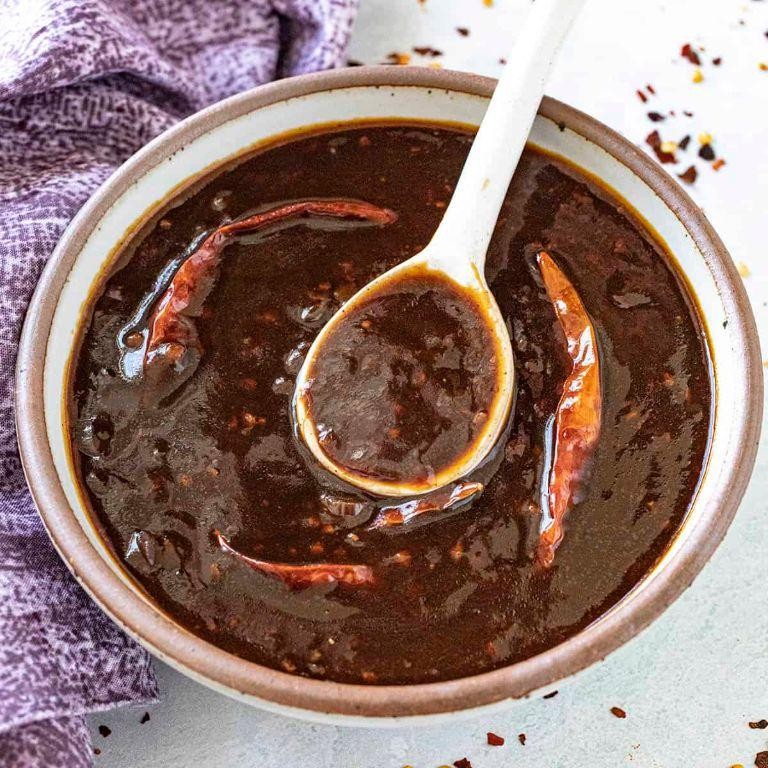
Discover the vibrant flavors of Kung Pao Sauce, a classic Chinese condiment that’s surprisingly simple to whip up at home. This guide will walk you through each step, ensuring you achieve that perfect balance of sweet, spicy, and tangy every time.
Ingredients
- 1/2 cup low-sodium soy sauce (I find it balances the saltiness perfectly)
- 1/4 cup rice vinegar (for that essential tang)
- 2 tbsp honey (a natural sweetener that adds depth)
- 1 tbsp sesame oil (my secret for a nutty aroma)
- 2 tsp crushed red pepper flakes (adjust based on your heat preference)
- 1 tbsp minced garlic (freshly minced makes all the difference)
- 1 tsp grated ginger (for a warm, spicy note)
- 1 tbsp cornstarch (to thicken the sauce to perfection)
- 1/4 cup water (room temperature blends better)
Instructions
- In a medium bowl, whisk together the soy sauce, rice vinegar, honey, and sesame oil until well combined.
- Add the crushed red pepper flakes, minced garlic, and grated ginger to the bowl, stirring to incorporate all the flavors.
- In a small separate bowl, dissolve the cornstarch in water to create a slurry, ensuring there are no lumps.
- Pour the cornstarch slurry into the sauce mixture, whisking continuously to prevent clumping.
- Transfer the sauce to a small saucepan and heat over medium heat, stirring constantly, until the sauce thickens to your desired consistency, about 3-5 minutes.
- Once thickened, remove from heat and let it cool slightly before using. The sauce will continue to thicken as it cools.
Enjoy the rich, glossy texture of your homemade Kung Pao Sauce, with its perfect harmony of flavors. Drizzle it over stir-fried chicken and peanuts for a classic dish, or get creative by using it as a marinade for grilled vegetables.
Mongolian BBQ Sauce
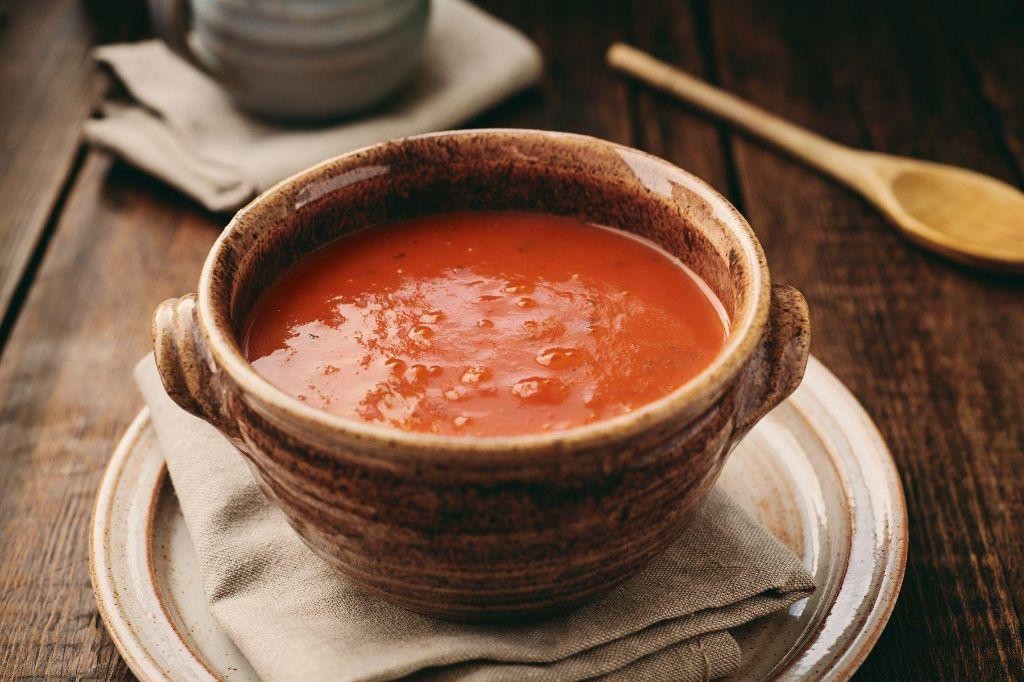
Preparing a homemade Mongolian BBQ sauce is simpler than you might think, and it’s a fantastic way to add a burst of flavor to your dishes. Let’s walk through the process together, ensuring you end up with a sauce that’s both delicious and versatile.
Ingredients
- 1/2 cup soy sauce (I always opt for low-sodium to control the saltiness)
- 1/4 cup brown sugar (packed tightly for that perfect sweetness)
- 2 tbsp hoisin sauce (this adds a depth of flavor that’s irreplaceable)
- 1 tbsp minced garlic (freshly minced makes all the difference)
- 1 tsp ginger paste (or freshly grated ginger for a sharper taste)
- 1/2 tsp red pepper flakes (adjust according to your heat preference)
- 1 tbsp cornstarch (this will thicken our sauce beautifully)
- 1/4 cup water (room temperature to mix smoothly with cornstarch)
Instructions
- In a medium saucepan, combine the soy sauce, brown sugar, hoisin sauce, minced garlic, ginger paste, and red pepper flakes over medium heat.
- Stir the mixture constantly until the brown sugar has completely dissolved, about 2-3 minutes.
- In a small bowl, whisk together the cornstarch and water until smooth to create a slurry.
- Slowly pour the cornstarch slurry into the saucepan, stirring continuously to prevent lumps.
- Bring the sauce to a gentle boil, then reduce the heat to low and simmer for 5 minutes, or until the sauce has thickened to your desired consistency. Tip: If the sauce thickens too much, you can thin it with a little water.
- Remove the saucepan from the heat and let the sauce cool slightly before using. Tip: The sauce will continue to thicken as it cools.
- Once cooled, taste and adjust the seasoning if necessary. Tip: For a smoother sauce, you can strain it through a fine mesh sieve.
After following these steps, you’ll have a rich, glossy Mongolian BBQ sauce with the perfect balance of sweet, savory, and spicy. Its velvety texture clings wonderfully to meats and vegetables, making it ideal for stir-fries or as a marinade. Try drizzling it over grilled chicken or using it as a dipping sauce for spring rolls to elevate your meal.
Orange Sauce
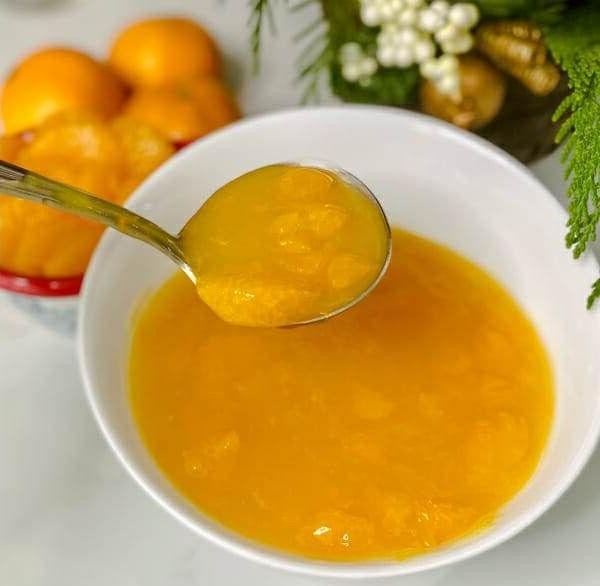
Perfect for adding a zesty kick to any dish, Orange Sauce is a versatile condiment that’s surprisingly simple to make. Let’s walk through the process together, ensuring you end up with a smooth, flavorful sauce every time.
Ingredients
- 1 cup fresh orange juice (I find squeezing it myself yields the best flavor)
- 1/2 cup granulated sugar (adjust slightly if you prefer a less sweet sauce)
- 2 tbsp cornstarch (this is my thickener of choice for its clarity and consistency)
- 1 tbsp orange zest (for that extra burst of citrus aroma)
- 1/4 tsp salt (just a pinch to balance the sweetness)
Instructions
- In a small saucepan, combine the orange juice and sugar over medium heat. Stir until the sugar is completely dissolved, about 2 minutes.
- In a separate bowl, mix the cornstarch with 2 tablespoons of cold water to create a slurry. This prevents lumps in your sauce.
- Slowly whisk the cornstarch slurry into the orange juice mixture. Continue to cook, stirring constantly, until the sauce thickens to your desired consistency, about 3-5 minutes.
- Remove the saucepan from the heat and stir in the orange zest and salt. Let the sauce cool for a few minutes before serving to allow the flavors to meld.
Rich in flavor with a velvety texture, this Orange Sauce is a delightful drizzle over grilled chicken or pancakes. For a creative twist, try mixing it into your morning yogurt or as a glaze for baked goods.
Lemon Sauce
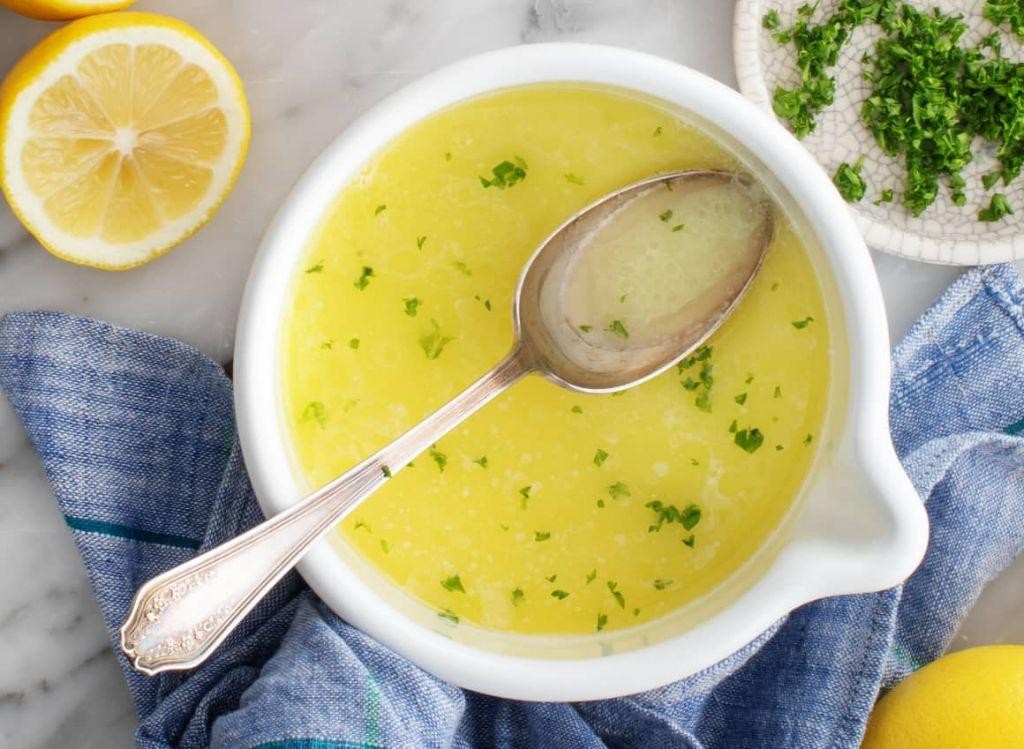
Mastering the art of making lemon sauce is simpler than you might think, and it’s a versatile condiment that can elevate both sweet and savory dishes. Let’s walk through the process together, ensuring you end up with a perfectly balanced sauce every time.
Ingredients
- 1 cup fresh lemon juice (strained to avoid seeds, I always use Meyer lemons for a slightly sweeter profile)
- 1/2 cup granulated sugar (adjust based on your sweetness preference, but this is my sweet spot)
- 2 tbsp unsalted butter (cold, cut into small pieces for easier melting)
- 1 tsp lemon zest (for that extra burst of flavor, make sure to zest before juicing)
- 1/4 tsp salt (just a pinch to balance the flavors)
Instructions
- In a medium saucepan, combine the lemon juice, sugar, and lemon zest over medium heat. Stir until the sugar is completely dissolved, about 3 minutes.
- Reduce the heat to low and gradually add the butter, one piece at a time, whisking constantly until each piece is fully incorporated before adding the next.
- Continue to cook the sauce on low heat for another 5 minutes, stirring occasionally, until it thickens slightly. Tip: The sauce should coat the back of a spoon when it’s ready.
- Remove the saucepan from the heat and stir in the salt. Tip: Taste the sauce now and adjust the sweetness or tartness by adding a bit more sugar or lemon juice if needed.
- Let the sauce cool for about 10 minutes before using. Tip: For a smoother sauce, strain it through a fine-mesh sieve to remove the zest.
Kick your dishes up a notch with this lemon sauce; its bright, tangy flavor and silky texture make it perfect for drizzling over pancakes, mixing into yogurt, or as a glaze for grilled chicken. The versatility of this sauce means it’s bound to become a staple in your kitchen.
Garlic Sauce
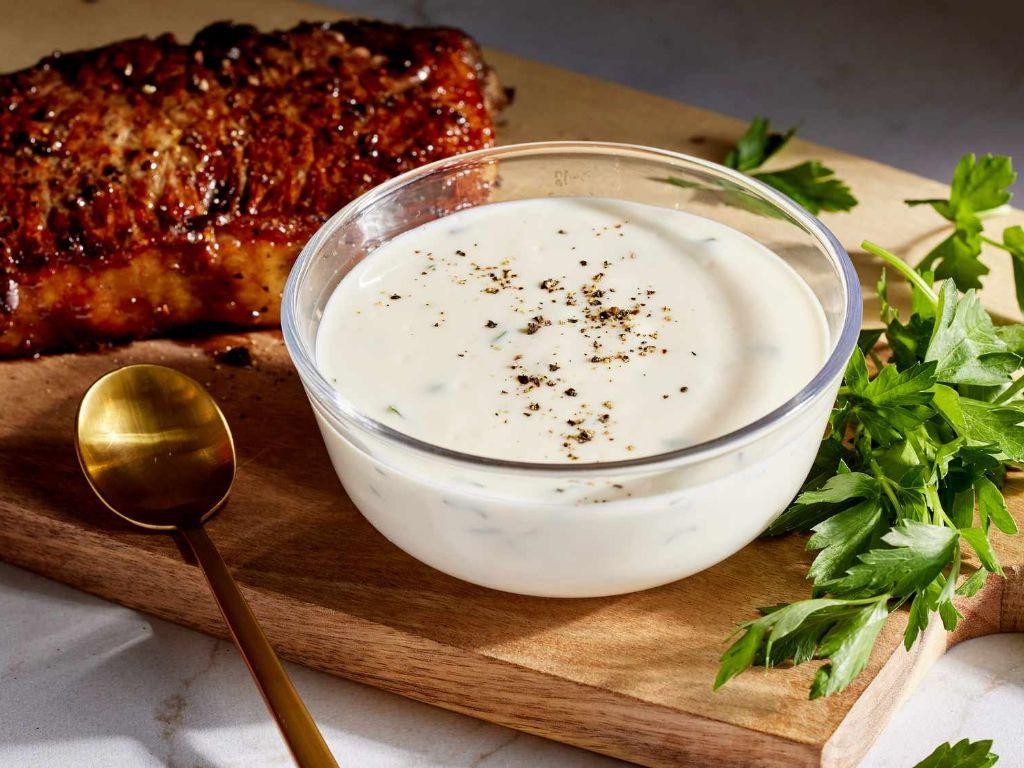
Very few condiments can transform a dish as dramatically as garlic sauce does, with its creamy texture and bold flavor. Today, we’re breaking down how to make this versatile sauce from scratch, ensuring even beginners can achieve perfect results every time.
Ingredients
- 1 cup mayonnaise (I swear by Duke’s for its rich flavor)
- 5 cloves garlic, minced (fresh is key here for that punchy aroma)
- 2 tbsp lemon juice (freshly squeezed makes all the difference)
- 1 tbsp extra virgin olive oil (my go-to for its fruity notes)
- 1/2 tsp salt (fine sea salt dissolves best)
- 1/4 tsp black pepper (freshly ground for maximum flavor)
Instructions
- In a medium bowl, combine 1 cup mayonnaise and 5 cloves of minced garlic. Stir until the garlic is evenly distributed throughout the mayonnaise.
- Add 2 tbsp lemon juice to the mixture. The acidity will brighten the sauce, so don’t skip this step.
- Drizzle in 1 tbsp extra virgin olive oil while stirring continuously to emulsify the sauce, ensuring a smooth consistency.
- Season with 1/2 tsp salt and 1/4 tsp black pepper. Taste and adjust the seasoning if necessary, but remember the flavors will meld as it sits.
- Cover the bowl with plastic wrap and refrigerate for at least 1 hour before serving. This resting time allows the garlic flavor to mellow and infuse throughout the sauce.
Zesty and creamy, this garlic sauce is the perfect accompaniment to grilled meats, roasted vegetables, or even as a bold sandwich spread. For an extra kick, try adding a pinch of cayenne pepper before serving.
Ginger Sauce
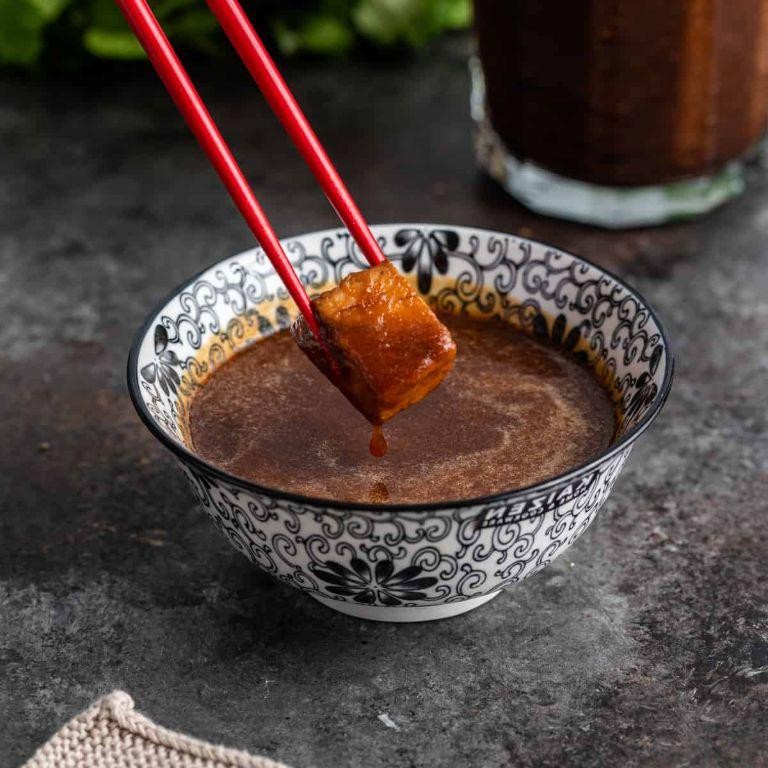
Savor the vibrant flavors of homemade Ginger Sauce, a versatile condiment that can elevate any dish from good to unforgettable. This guide will walk you through each step, ensuring even beginners can achieve perfect results.
Ingredients
- 1 cup fresh ginger, peeled and finely grated (I find young ginger less fibrous and more flavorful)
- 1/4 cup soy sauce (opt for low-sodium to control the saltiness)
- 2 tbsp rice vinegar (adds a nice tanginess)
- 1 tbsp honey (for a subtle sweetness)
- 1/2 cup water (to adjust consistency)
- 1 clove garlic, minced (because garlic makes everything better)
- 1 tsp sesame oil (my secret for depth of flavor)
Instructions
- In a medium bowl, combine the grated ginger, soy sauce, rice vinegar, honey, and minced garlic. Stir until the honey is fully dissolved.
- Heat the sesame oil in a small saucepan over medium heat for about 30 seconds, just until it becomes fragrant.
- Pour the ginger mixture into the saucepan and bring to a gentle simmer, stirring occasionally. Let it simmer for 5 minutes to meld the flavors together.
- Gradually add water, a tablespoon at a time, until the sauce reaches your desired consistency. Remember, it will thicken slightly as it cools.
- Remove from heat and let the sauce cool to room temperature before serving. This allows the flavors to develop fully.
Just like that, you’ve created a Ginger Sauce with a perfect balance of spicy, sweet, and tangy notes. Its smooth texture makes it ideal for drizzling over grilled meats or mixing into stir-fries for an extra flavor kick.
Sesame Sauce
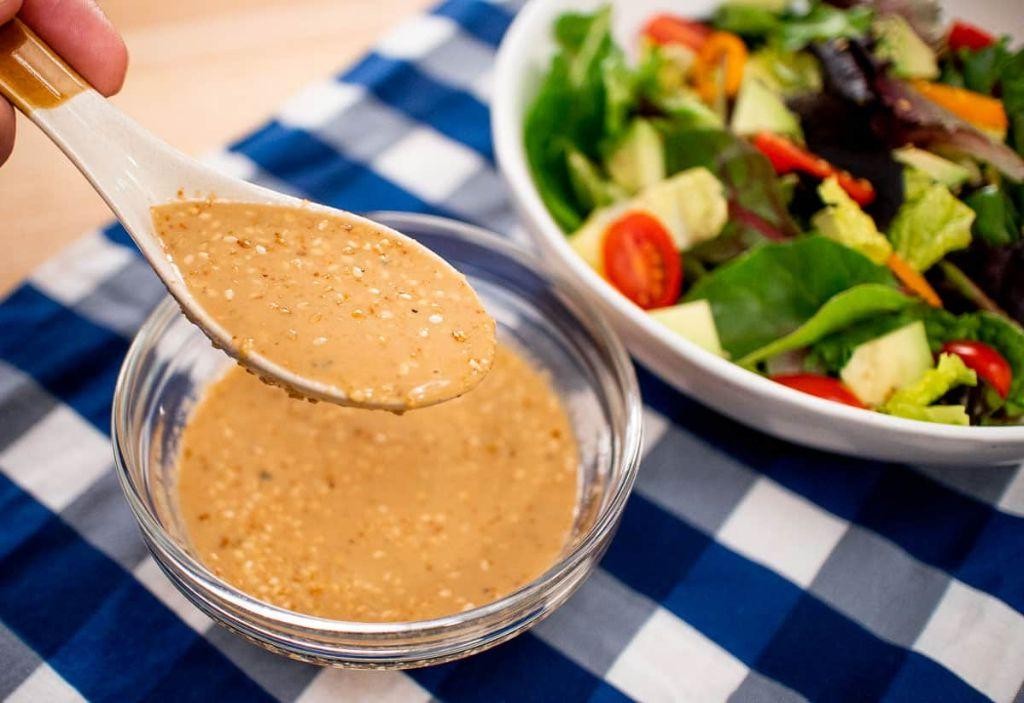
How delightful it is to whip up a batch of homemade sesame sauce, a versatile condiment that can elevate any dish from mundane to extraordinary with its rich, nutty flavor. This recipe is designed for beginners, guiding you through each step with precision to ensure a perfect result every time.
Ingredients
– 1/2 cup tahini (I love the creamy texture it brings)
– 1/4 cup warm water (helps in achieving the perfect consistency)
– 2 tbsp soy sauce (for that umami kick)
– 1 tbsp maple syrup (a personal favorite for a hint of sweetness)
– 1 clove garlic, minced (fresh is always best)
– 1 tsp rice vinegar (adds a subtle tang)
– 1/2 tsp sesame oil (toasted, for an extra layer of flavor)
– A pinch of salt (to balance the flavors)
Instructions
1. In a medium bowl, combine the tahini and warm water, whisking until smooth. Tip: If the mixture seems too thick, add water one tablespoon at a time until desired consistency is reached.
2. Add the soy sauce, maple syrup, minced garlic, rice vinegar, sesame oil, and salt to the bowl. Whisk vigorously until all ingredients are fully incorporated. Tip: Taste as you go and adjust the seasoning if necessary, but remember the flavors will meld and intensify as the sauce sits.
3. Let the sauce sit at room temperature for at least 10 minutes before serving to allow the flavors to develop. Tip: For a smoother sauce, you can blend all the ingredients in a food processor for about 30 seconds.
Drizzle this luscious sesame sauce over grilled vegetables, noodles, or use it as a dressing for salads. Its creamy texture and complex flavor profile make it a standout addition to any meal, promising to leave your taste buds craving more.
Conclusion
From savory to sweet, our roundup of 20 Delicious Chinese Sauces Recipes offers a treasure trove of flavors to elevate your home cooking. Whether you’re a novice or a seasoned chef, there’s something here to inspire your next meal. We’d love to hear which recipes become your favorites—drop us a comment below! And if you enjoyed this article, don’t forget to share the love on Pinterest. Happy cooking!


